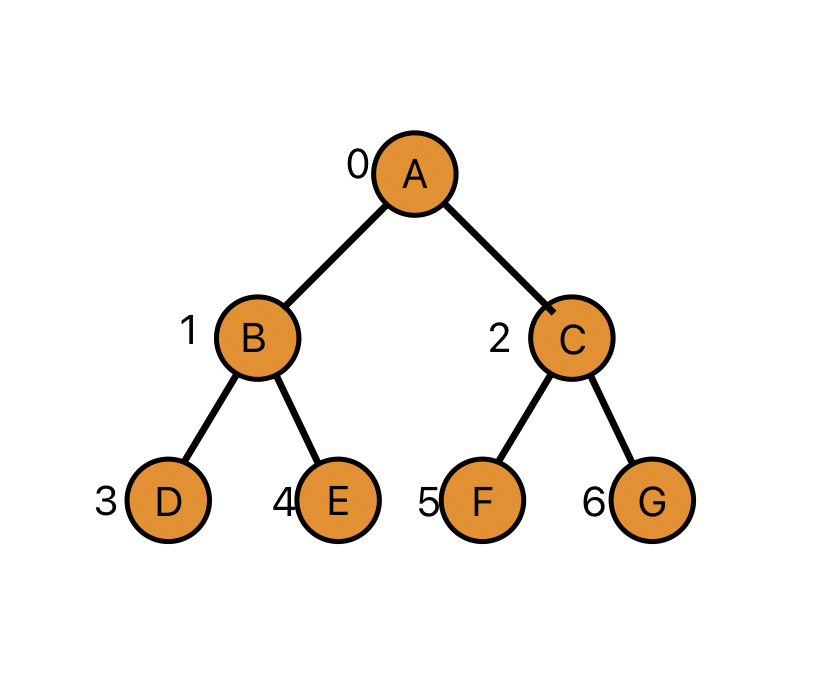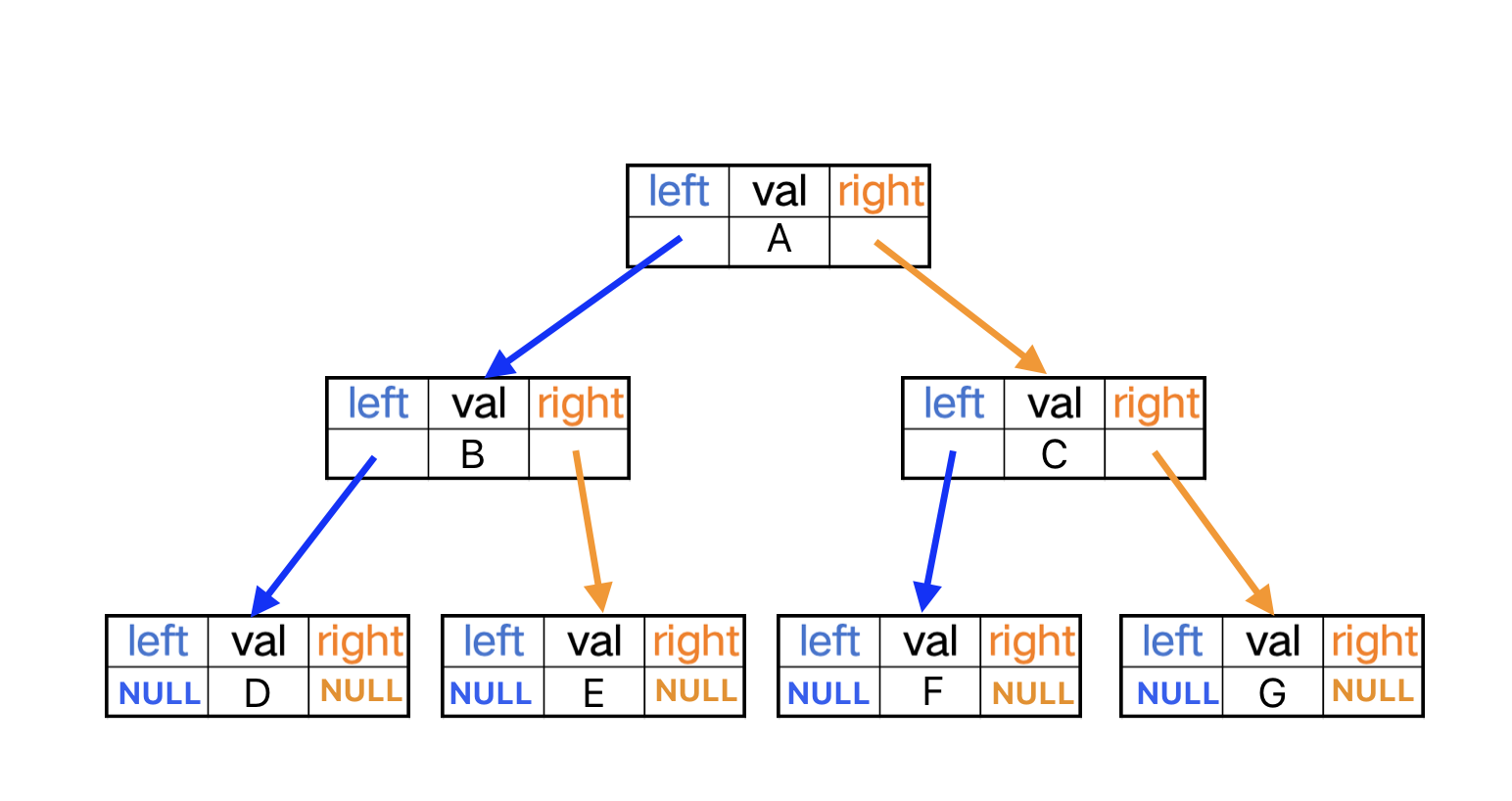1.二叉树的链式结构
此前,我们通过数组(顺序表)完成了二叉树的顺序存储,并实现了二叉树的基础功能
那么,二叉树还有没有其他存储方式呢?
前面我们学习了链表,它是一种线性 结构,而二叉树是一种非线性 结构,但是通过思考,我们发现链表是通过next指针把一个一个的节点连接起来的,那么我们如何用相似的方式把二叉树相应的节点连接起来呢?
cpp
//链表节点
typedef int LTDataType;//存储的数据类型
typedef struct ListNode{
LTDataType val;//数据值
struct ListNode* next;//指向下一个节点
}LTNOde;
通过观察,我们发现二叉树中,节点最大的度为2 (每个节点最多连接两个字节点),所以我们可以在链表节点的基础上,再添加一个指针,用两个指针来指向子节点 ,即可把整个二叉树连接起来,形成一个链式结构
cpp
typedef int BTDataType;//存储的数据类型
typedef struct BinaryTreeNode{
LTDataType val;//数据值
//指向左子节点
struct BinaryTreeNode* left;
//指向右子节点
struct BinaryTreeNode* right;
}BTNode;
2.链式结构的遍历顺序
链式结构的遍历顺序分为三种:前序遍历、中序遍历、后序遍历
注 :他们的顺序都是相对于根节点的
前序遍历:根 节点-左节点-右节点
中序遍历:左节点-根 节点-右节点
后续遍历:左节点-右节点-根节点
2.1.前序遍历
从根节点开始遍历,然后遍历左子树,最后遍历右子树

- 根节点为A(当前前序遍历结果:A)
- 再遍历A的左子树,继续以根-左-右 的顺序遍历,找到子树的根节点B(当前前序遍历结果:A-B)
- 遍历B的左子树,找到D,D没有子树了,所以B的左子树遍历完了(当前前序遍历结果:A-B-D)
- B的根和左子树遍历完了,开始遍历B的右子树,找到节点E,此时A的左子树遍历完了(当前前序遍历结果:A-B-D-E)
- A的根和左子树遍历完了,开始遍历A的右子树
- 找到A的子树的根节点C(当前前序遍历结果:A-B-D-E-C)
- 开始遍历C的左子树,找到F,C的左子树遍历完毕(当前前序遍历结果:A-B-D-E-C-F)
- 开始遍历C的右子树,找到G,此时A的右子树遍历完毕(当前前序遍历结果:A-B-D-E-C-F-G)
- 前序遍历完成
- 最终结果为A-B-D-E-C-F-G
2.1.中序遍历
从左子树开始遍历,再遍历根节点,最后遍历右子树

-
先遍历根节点A的左子树,来到子树中的根节点B,他有左子树,继续向下遍历找他的左子树,找到节点D,由于D没有左子树了,所以取D(当前中序遍历 结果:D-)
-
B的左子树遍历完了,遍历根B本身,取B(当前中序遍历 结果:D-😎
-
遍历B的右子树,找到E,E没有子树了,取E,B的右子树遍历完成(当前中序遍历 结果:D-B-E)
-
此时A的左子树遍历完成,遍历根A本身,取A(当前中序遍历 结果:D-B-E-A)
-
A的左子树和根遍历完成,遍历A的右子树来到C,C有左子树,来到F,F没有子树了,取F(当前中序遍历 结果:D-B-E-A-F)
-
C的左子树遍历完成,遍历根C本身,取节点C(当前中序遍历 结果:D-B-E-A-F-C)
-
C的左子树和根遍历完成,遍历右子树,找到节点G,它没有子树了,取G(当前中序遍历 结果:D-B-E-A-F-C-G)
-
A的右子树遍历完成,中序遍历完毕
-
最终结果为D-B-E-A-F-C-G
2.3.后序遍历
从左子树开始遍历,再遍历右子树,最后遍历根

- 先遍历根A的左子树,找到节点B,B有左子树,继续遍历,找到节点D,D没有子树了,取D(当前后序遍历结果:D)
- B的左子树遍历完成,继续遍历它的右子树,找到节点E,没有子树了,取E(当前后序遍历结果:D-E)
- B的右子树遍历完成,取B本身(当前后序遍历结果:D-E-B)
- A的左子树遍历完成,继续遍历A的右子树,找到节点C,继续遍历C的左子树,找到节点F,F没有子树了,取F(当前后序遍历结果:D-E-B-F)
- C的左子树遍历完成,继续遍历它的右子树,找到节点G,G没有子树了,取G(当前后序遍历结果:D-E-B-F-G)
- C的左右子树遍历完成,取根C本身(当前后序遍历结果:D-E-B-F-G-C)
- 此时A的左右子树遍历完成,取根A本身(当前后序遍历结果:D-E-B-F-G-C-A)
- 后序遍历完成,最终结果为D-E-B-F-G-C-A
3.二叉树链式结构的实现
3.1.二叉树节点结构的定义
一个结构体类型,成员包含存储数据的值 和分别指向左孩子和右孩子的左右指针
cpp
typedef char BTDataType;
typedef struct BinaryTreeNode
{
BTDataType _data;
struct BinaryTreeNode* _left;
struct BinaryTreeNode* _right;
}BTNode;3.2.创建节点
开辟一个节点大小的空间,把数据值存入该节点,返回这片空间的地址
cpp
BTNode* BTBuyNode(BTDataType x)
{
BTNode* newNode = (BTNode*)malloc(sizeof(BTNode));
if(newNode == NULL)
{
perror("malloc error!\n");
return NULL;
}
newNode->_data = x;
newNode->_left = newNode->_right = NULL;
return newNode;
}3.3.创建二叉树
以前序遍历为例,把数组中的数据,转化为链式结构,存储到二叉树中
cpp
BTNode* BinaryTreeCreate(BTDataType* a, int n, int* pi)
{
if(*pi >= n || a[*pi] == '#')
{
(*pi)++;
return NULL;
}
BTNode* root = BTBuyNode(a[(*pi)++]);
root->_left = BinaryTreeCreate(a, n, pi);
root->_right = BinaryTreeCreate(a, n, pi);
return root;
}注:形参中的pi必须传指针(传址调用),因为在递归过程中该形参会发生改变,如果采用传值调用,该形参值不能被正常修改
3.4.二叉树链式结构的销毁
以后序遍历的方式,先销毁左右子树,最后销毁根节点(如果先销毁根节点,那就找不到它的左右指针了,不能进行后续操作)
cpp
//左-右-根
void BinaryTreeDestory(BTNode** root)
{
if(root == NULL || *root == NULL)
{
return ;
}
//注:传二级指针--指针的地址
BinaryTreeDestory(&((*root)->_left));
BinaryTreeDestory(&((*root)->_right));
free(*root);
*root = NULL;
}3.5.节点总数
用递归的方式,返回左子树的节点个数+右子树的节点个数+根即可
cpp
int BinaryTreeSize(BTNode* root)
{
if(root == NULL) return 0;
return 1 + BinaryTreeSize(root->_left) + BinaryTreeSize(root->_right);
}3.6.叶子节点数
同样用递归的方式,返回左子树的叶子节点数+右子树的叶子节点数,当该节点没有左右子树时,即为叶子节点,返回1
cpp
int BinaryTreeLeafSize(BTNode* root)
{
if(root == NULL) return 0;
if(!root->_left && !root->_right) return 1;
return BinaryTreeLeafSize(root->_left) + BinaryTreeLeafSize(root->_right);
}3.7.返回第K层的节点数
同样采用递归的方式,第K层节点数=根节点左子树的第K-1层节点数+根节点的右子树的第K-1层节点数,以此类推,每递归一次都减少一层···
cpp
int BinaryTreeLevelKSize(BTNode* root, int k)
{
if(root == NULL || k < 1) return 0;
if(k == 1) return 1;
return BinaryTreeLevelKSize(root->_left, k-1) + BinaryTreeLevelKSize(root->_right, k-1);
}3.8.查找节点
还是采用递归的方式,从根节点开始,遍历每一个节点,直到遇到目标值,返回该节点的地址
cpp
BTNode* BinaryTreeFind(BTNode* root, BTDataType x)
{
if(root == NULL) return NULL;
if(root->_data == x) return root;
BTNode* Left = BinaryTreeFind(root->_left, x);
BTNode* Right = BinaryTreeFind(root->_right, x);
if(Left) return Left;
if(Right) return Right;
return NULL;
}3.9.前序遍历
先打印根节点数据,再分别递归调用左子树和右子树
cpp
//根-左-右
void BinaryTreePrevOrder(BTNode* root)
{
if(root == NULL) return;
printf("%c ", root->_data);
BinaryTreePrevOrder(root->_left);
BinaryTreePrevOrder(root->_right);
}3.10.中序遍历
先递归调用左子树,再打印根节点数据,最后递归调用右子树
cpp
//左-根-右
void BinaryTreeInOrder(BTNode* root)
{
if(root == NULL) return;
BinaryTreeInOrder(root->_left);
printf("%c ", root->_data);
BinaryTreeInOrder(root->_right);
}3.11.后序遍历
先分别递归调用左右子树,再打印根节点
cpp
//左-右-根
void BinaryTreePostOrder(BTNode* root)
{
if(root == NULL) return;
BinaryTreePostOrder(root->_left);
BinaryTreePostOrder(root->_right);
printf("%c ", root->_data);
}3.12.层序遍历
由于每一个节点都是通过指针连接的后继节点,所以一层一层地调用是不现实的,这个时候我们可以借助队列来实现层序遍历:
创建一个队列,先让根节点入队,取出队列头节点并打印 ,(如果有的话)让它的左右孩子入队 ,若队列不为空,继续取出队头节点并打印,让它的左右孩子入队,重复以上操作,直到队列为空,则层序遍历完成
队列的实现(队列的详细讲解):
Queue.h
cpp
//
// Queue.h
#include <stdio.h>
#include <stdlib.h>
#include <assert.h>
#include <stdbool.h>
typedef struct BinaryTreeNode BTNode;
//队列节点的结构
typedef struct QueueNode{
BTNode* data;
struct QueueNode* next;
}QueueNode;
//队列的结构
typedef struct Queue{
QueueNode* front;
QueueNode* rear;
}Queue;
//初始化队列
void QueueInit(Queue* pq);
//入队
void QueuePush(Queue* pq, BTNode* x);
//判空
bool QueueEmpty(Queue* pq);
//出队
void QueuePop(Queue* pq);
//取队头
BTNode* QueueFront(Queue* pq);
//销毁队列
void QueueDestroy(Queue* pq);Queue.c
cpp
//
// Queue.c
#include "Queue.h"
void QueueInit(Queue* pq)
{
assert(pq);
pq->front = pq->rear = NULL;
}
void QueuePush(Queue* pq, BTNode* x)
{
assert(pq);
QueueNode* newQueNode = (QueueNode*)malloc(sizeof(QueueNode));
if(newQueNode == NULL)
{
perror("malloc fail!\n");
return;
}
newQueNode->data = x;
newQueNode->next = NULL;
if(pq->front == NULL)
{
pq->front = pq->rear = newQueNode;
}
else
{
pq->rear->next = newQueNode;
pq->rear = newQueNode;
}
}
bool QueueEmpty(Queue* pq)
{
assert(pq);
return pq->front == NULL;
}
void QueuePop(Queue* pq)
{
assert(!QueueEmpty(pq));
QueueNode* del = pq->front;
pq->front = del->next;
if(pq->front == NULL)
{
pq->rear = NULL;
}
free(del);
del = NULL;
}
BTNode* QueueFront(Queue* pq)
{
assert(!QueueEmpty(pq));
return pq->front->data;
}
void QueueDestroy(Queue* pq)
{
//节点
QueueNode* pcur = pq->front;
while(pcur)
{
QueueNode* next= pcur->next;
free(pcur);
pcur = next;
}
//队列首尾
pq->front = pq->rear = NULL;
}层序遍历:
cpp
void BinaryTreeLevelOrder(BTNode* root)
{
if(root == NULL) return;
Queue q;
QueueInit(&q);
QueuePush(&q, root);
while(!QueueEmpty(&q))
{
BTNode* top = QueueFront(&q);
QueuePop(&q);
printf("%c ", top->_data);
if(top->_left) QueuePush(&q, top->_left);
if(top->_right) QueuePush(&q, top->_right);
}
QueueDestroy(&q);
}3.13.判断是否为完全二叉树
我们知道,完全二叉树是由满二叉树得来的,在完全二叉树中,最后一层以上 的所有层次中,节点数都达到了最大值 ,而最后一层不一定 ,但一定满足节点从左到右 依次排列
因此,我们可以通过此性质,仿照层次遍历的方式,通过队列 ,来实现完全二叉树的判定
注:取队头时,不需要判断左右孩子是否为空,直接入队即可,当队列头节点为空时,跳出循环,此时判断队列后序数据是否存在非空值,若存在,则不是完全二叉树,不存在,则是完全二叉树
cpp
bool BinaryTreeComplete(BTNode* root)
{
//当遍历到空节点时 递归结束
if(root == NULL) return true;
Queue q;
QueueInit(&q);
while(!QueueEmpty(&q))
{
BTNode* top = QueueFront(&q);
QueuePop(&q);
//判断是否为空节点
if(top == NULL)
{
break;
}
//左右子树入队
QueuePush(&q, top->_left);
QueuePush(&q, top->_right);
}
//检查剩余元素
while(!QueueEmpty(&q))
{
BTNode* top = QueueFront(&q);
QueuePop(&q);
//判断队头元素
if(top != NULL)
{
QueueDestroy(&q);
return false;
}
}
QueueDestroy(&q);
return true;
}4.完整代码
Queue.h
cpp
//
// Queue.h
#include <stdio.h>
#include <stdlib.h>
#include <assert.h>
#include <stdbool.h>
typedef struct BinaryTreeNode BTNode;
//队列节点的结构
typedef struct QueueNode{
BTNode* data;
struct QueueNode* next;
}QueueNode;
//队列的结构
typedef struct Queue{
QueueNode* front;
QueueNode* rear;
}Queue;
//初始化队列
void QueueInit(Queue* pq);
//入队
void QueuePush(Queue* pq, BTNode* x);
//判空
bool QueueEmpty(Queue* pq);
//出队
void QueuePop(Queue* pq);
//取队头
BTNode* QueueFront(Queue* pq);
//销毁队列
void QueueDestroy(Queue* pq);Tree.h
cpp
//
// Tree.h
#pragma once
#include <stdio.h>
#include <stdlib.h>
#include <assert.h>
#include <stdbool.h>
#include <string.h>
typedef char BTDataType;
typedef struct BinaryTreeNode
{
BTDataType _data;
struct BinaryTreeNode* _left;
struct BinaryTreeNode* _right;
}BTNode;
//创建节点
BTNode* BTBuyNode(BTDataType x);
// 通过前序遍历的数组"ABD##E#H##CF##G##"构建二叉树
BTNode* BinaryTreeCreate(BTDataType* a, int n, int* pi);
// 二叉树销毁
void BinaryTreeDestory(BTNode** root);
// 二叉树节点个数
int BinaryTreeSize(BTNode* root);
// 二叉树叶子节点个数
int BinaryTreeLeafSize(BTNode* root);
// 二叉树第k层节点个数
int BinaryTreeLevelKSize(BTNode* root, int k);
// 二叉树查找值为x的节点
BTNode* BinaryTreeFind(BTNode* root, BTDataType x);
// 二叉树前序遍历
void BinaryTreePrevOrder(BTNode* root);
// 二叉树中序遍历
void BinaryTreeInOrder(BTNode* root);
// 二叉树后序遍历
void BinaryTreePostOrder(BTNode* root);
// 层序遍历
void BinaryTreeLevelOrder(BTNode* root);
// 判断二叉树是否是完全二叉树
bool BinaryTreeComplete(BTNode* root);Queue.c
cpp
//
// Queue.c
#include "Queue.h"
void QueueInit(Queue* pq)
{
assert(pq);
pq->front = pq->rear = NULL;
}
void QueuePush(Queue* pq, BTNode* x)
{
assert(pq);
QueueNode* newQueNode = (QueueNode*)malloc(sizeof(QueueNode));
if(newQueNode == NULL)
{
perror("malloc fail!\n");
return;
}
newQueNode->data = x;
newQueNode->next = NULL;
if(pq->front == NULL)
{
pq->front = pq->rear = newQueNode;
}
else
{
pq->rear->next = newQueNode;
pq->rear = newQueNode;
}
}
bool QueueEmpty(Queue* pq)
{
assert(pq);
return pq->front == NULL;
}
void QueuePop(Queue* pq)
{
assert(!QueueEmpty(pq));
QueueNode* del = pq->front;
pq->front = del->next;
if(pq->front == NULL)
{
pq->rear = NULL;
}
free(del);
del = NULL;
}
BTNode* QueueFront(Queue* pq)
{
assert(!QueueEmpty(pq));
return pq->front->data;
}
void QueueDestroy(Queue* pq)
{
//节点
QueueNode* pcur = pq->front;
while(pcur)
{
QueueNode* next= pcur->next;
free(pcur);
pcur = next;
}
//队列首尾
pq->front = pq->rear = NULL;
}Tree.c
cpp
//
// Tree.c
#include "Tree.h"
#include "Queue.h"
BTNode* BTBuyNode(BTDataType x)
{
BTNode* newNode = (BTNode*)malloc(sizeof(BTNode));
if(newNode == NULL)
{
perror("malloc error!\n");
return NULL;
}
newNode->_data = x;
newNode->_left = newNode->_right = NULL;
return newNode;
}
//前序:根-左-右
BTNode* BinaryTreeCreate(BTDataType* a, int n, int* pi)
{
if(*pi >= n || a[*pi] == '#')
{
(*pi)++;
return NULL;
}
BTNode* root = BTBuyNode(a[(*pi)++]);
root->_left = BinaryTreeCreate(a, n, pi);
root->_right = BinaryTreeCreate(a, n, pi);
return root;
}
//左-右-根
void BinaryTreeDestory(BTNode** root)
{
if(root == NULL || *root == NULL)
{
return ;
}
BinaryTreeDestory(&((*root)->_left));
BinaryTreeDestory(&((*root)->_right));
free(*root);
*root = NULL;
}
int BinaryTreeSize(BTNode* root)
{
if(root == NULL) return 0;
return 1 + BinaryTreeSize(root->_left) + BinaryTreeSize(root->_right);
}
int BinaryTreeLeafSize(BTNode* root)
{
if(root == NULL) return 0;
if(!root->_left && !root->_right) return 1;
return BinaryTreeLeafSize(root->_left) + BinaryTreeLeafSize(root->_right);
}
int BinaryTreeLevelKSize(BTNode* root, int k)
{
if(root == NULL || k < 1) return 0;
if(k == 1) return 1;
return BinaryTreeLevelKSize(root->_left, k-1) + BinaryTreeLevelKSize(root->_right, k-1);
}
BTNode* BinaryTreeFind(BTNode* root, BTDataType x)
{
if(root == NULL) return NULL;
if(root->_data == x) return root;
BTNode* Left = BinaryTreeFind(root->_left, x);
BTNode* Right = BinaryTreeFind(root->_right, x);
if(Left) return Left;
if(Right) return Right;
return NULL;
}
//根-左-右
void BinaryTreePrevOrder(BTNode* root)
{
if(root == NULL) return;
printf("%c ", root->_data);
BinaryTreePrevOrder(root->_left);
BinaryTreePrevOrder(root->_right);
}
//左-根-右
void BinaryTreeInOrder(BTNode* root)
{
if(root == NULL) return;
BinaryTreeInOrder(root->_left);
printf("%c ", root->_data);
BinaryTreeInOrder(root->_right);
}
//左-右-根
void BinaryTreePostOrder(BTNode* root)
{
if(root == NULL) return;
BinaryTreePostOrder(root->_left);
BinaryTreePostOrder(root->_right);
printf("%c ", root->_data);
}
//借助队列来实现
void BinaryTreeLevelOrder(BTNode* root)
{
if(root == NULL) return;
Queue q;
QueueInit(&q);
QueuePush(&q, root);
while(!QueueEmpty(&q))
{
BTNode* top = QueueFront(&q);
QueuePop(&q);
printf("%c ", top->_data);
if(top->_left) QueuePush(&q, top->_left);
if(top->_right) QueuePush(&q, top->_right);
}
QueueDestroy(&q);
}
bool BinaryTreeComplete(BTNode* root)
{
if(root == NULL) return true;
Queue q;
QueueInit(&q);
while(!QueueEmpty(&q))
{
BTNode* top = QueueFront(&q);
QueuePop(&q);
if(top == NULL)
{
break;
}
QueuePush(&q, top->_left);
QueuePush(&q, top->_right);
}
while(!QueueEmpty(&q))
{
BTNode* top =QueueFront(&q);
QueuePop(&q);
if(top != NULL)
{
QueueDestroy(&q);
return false;
}
}
QueueDestroy(&q);
return true;
}main.c
cpp
//
// main.c
#include "Tree.h"
void test(void)
{
char str[] = "ABD##E#H##CF##G##";
int i = 0;
int n = (int)strlen(str);
BTNode* root = BinaryTreeCreate(str, n, &i);
printf("二叉树节点总数为:%d\n", BinaryTreeSize(root));
printf("二叉树叶子结点数为:%d\n", BinaryTreeLeafSize(root));
printf("二叉树第2层节点数为:%d\n", BinaryTreeLevelKSize(root, 2));
printf("节点'F'所在地址为:%p\n", BinaryTreeFind(root, 'F'));
printf("二叉树前序遍历结果为:");
BinaryTreePrevOrder(root);printf("\n");
printf("二叉树中序遍历结果为:");
BinaryTreeInOrder(root);printf("\n");
printf("二叉树后序遍历结果为:");
BinaryTreePostOrder(root);printf("\n");
printf("二叉树层序遍历结果为:");
BinaryTreeLevelOrder(root);printf("\n");
BinaryTreeDestory(&root);
}
int main(void)
{
test();
return 0;
}运行结果
